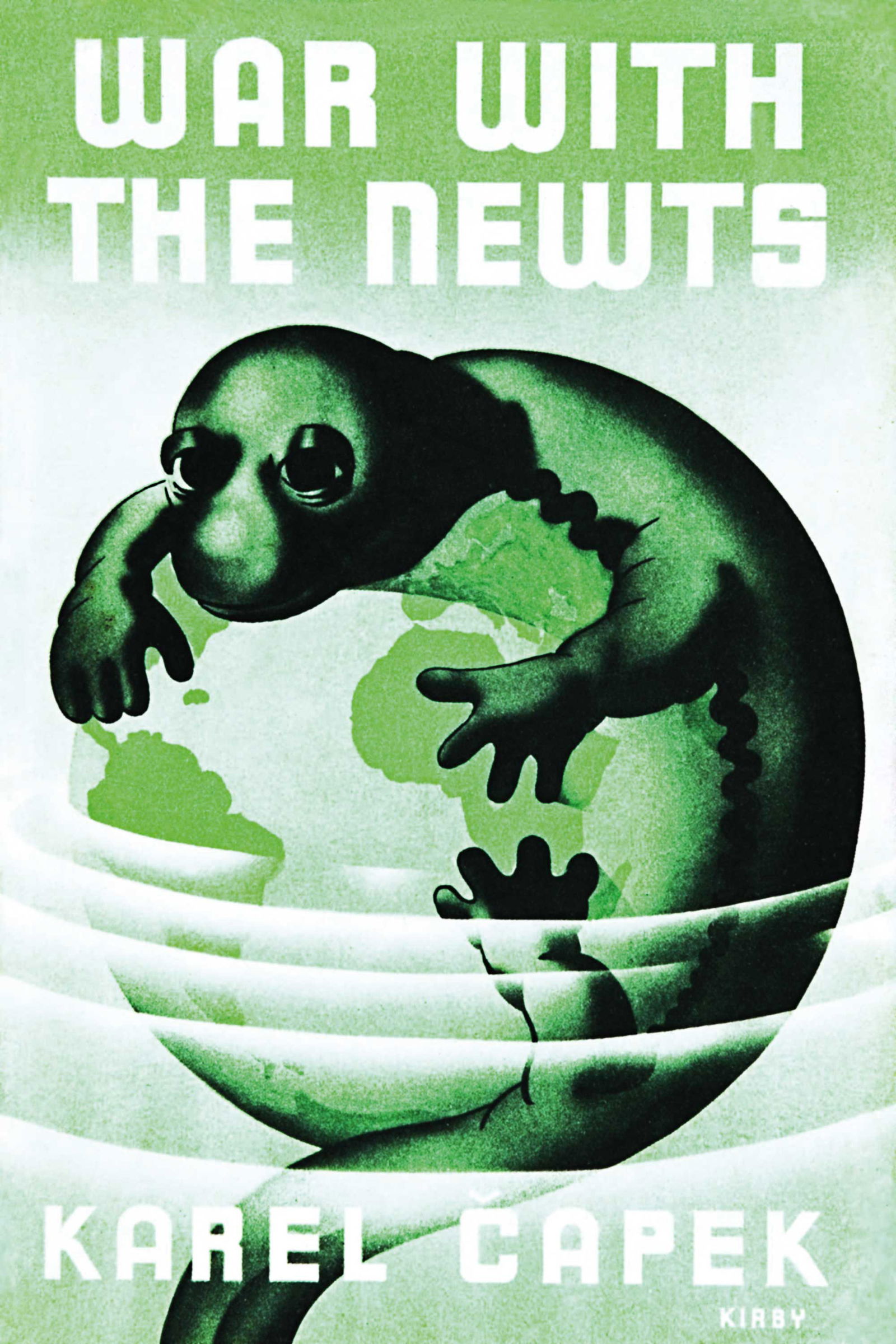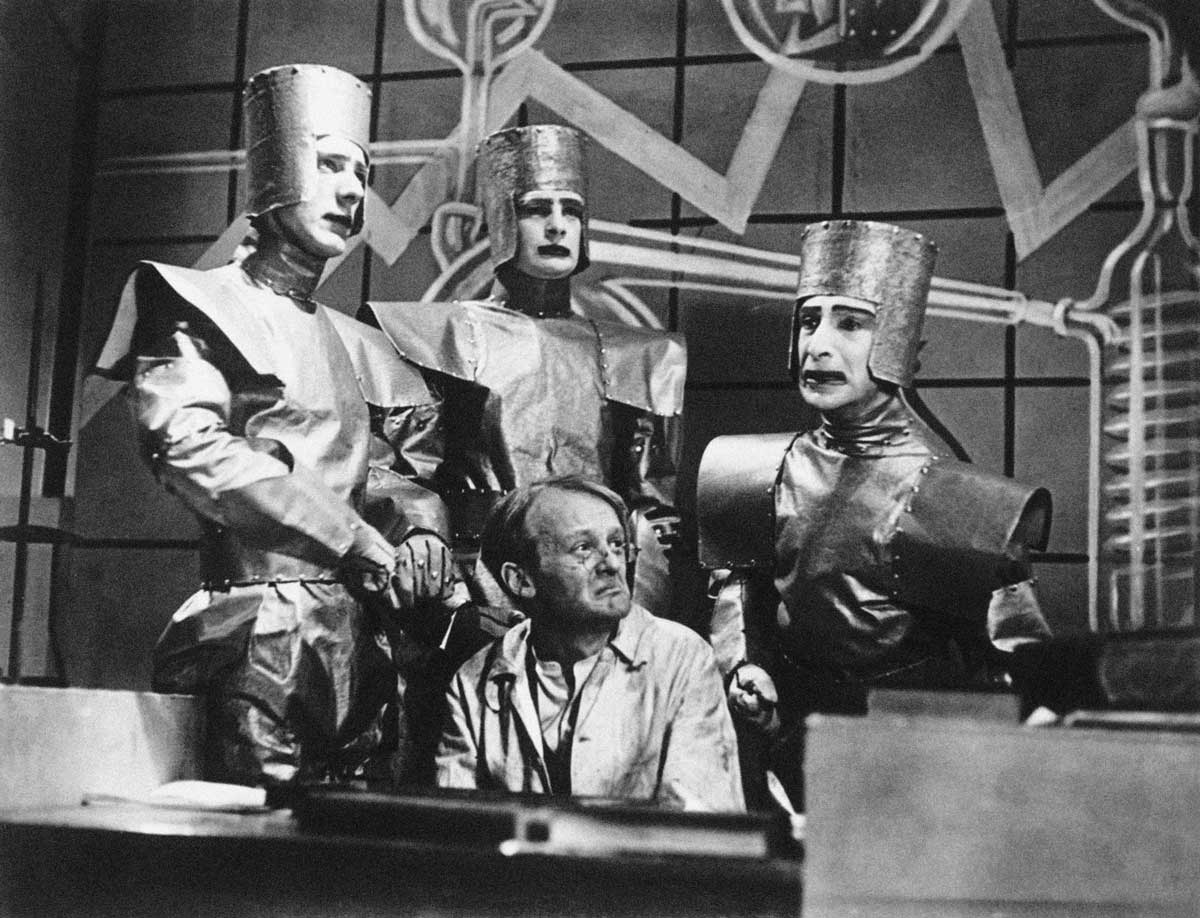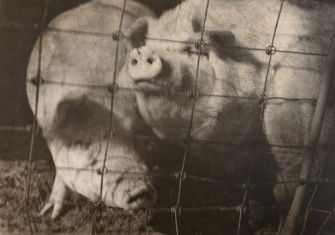The Rise of the Newts
A speculative novel about an amphibious threat held dire warnings for interwar Europe.

When Mr Povondra’s son spots a newt in the River Vlatava, he knows that the end is nigh. Soon, what remains of Europe will sink beneath the waves and his beloved Czechoslovakia will be no more. Povondra’s only hope is that his children will forgive him.
Like everyone else in Karel Čapek’s War with the Newts (1936), poor Mr Povondra had failed to see how terrible a threat the newts would become. It had all begun innocently enough. While fishing for pearls off the island of Tanah Masa, Captain Jan van Toch had chanced upon a race of intelligent, over-sized newts. Ignoring warnings from the local people, who regard them as ‘devils’, the Captain investigates further. On finding that they can be trained to perform simple tasks, he realises that they could be used to gather pearls more efficiently than any diver. All he needs is a boat to transport them, but, lacking the necessary funds, he has to abandon his plan. After returning to Czechoslovakia, however, he calls on Mr Bondy, a childhood friend and businessman. Despite nearly being turned away by Mr Povondra, the Captain convinces Bondy of the newts’ potential. Together they take newts from island to island, gathering vast numbers of pearls – so vast, in fact, that their value plummets.
The rise of the newts
Faced with the collapse of the market, Bondy’s company decides to put the newts to other uses. Dividing them into categories depending on their size and abilities, the ‘Salamander Syndicate’ sets them to work opening a new frontier of industrial production beneath the ocean. Before long, the seabed has become the dynamo of the global economy. To meet demand, newts are bred on special farms. Soon, there are hundreds of millions of them – and they begin to display dazzling intelligence. Curiously little is known about their affairs. No one is sure how they are organised, what their hopes might be, or even what they are doing under the waves. But such details hardly matter. A new golden age seems to be beginning. Thanks to the newts, the world is enjoying undreamt-of prosperity. No one sees any reason to worry.
Until, that is, things suddenly take a turn for the worse. Strange explosions take place in the English Channel and skirmishes break out between newts and men. With their population growing at an alarming rate, the newts desperately need more shallow waters in which to live. Since this can only be achieved by demolishing parts of the land, the ‘Chief Salamander’ demands to buy vast tracts and threatens dire consequences if he is denied. In the hope of appeasing the newts, humans grudgingly make concessions. But it is not enough. One by one entire continents are gobbled up.
What becomes of the newts thereafter is unclear. Čapek speculates that, having gained mastery of the earth, they would most probably split into rival factions. These would then wage a bitter war until the whole species was destroyed, at which point humanity would at last begin to rebuild.
Brave New World
At once painfully comical and plausibly tragic, War with the Newts reflects Čapek’s struggle with the brave new world in which he found himself. Born into a well-to-do family in northern Bohemia, he grew up amid the comfortable certainties of the Austro-Hungarian Empire. After studying literature and philosophy at Prague’s Charles University, he took up a career as a journalist. Like many other young men of his class, he flirted gently with radical politics and developed an early interest in modern art. But the First World War shocked him onto a different path. Though poor health saved him from the horrors of the front, he was taken aback by the transformations the conflict unleashed. In what seemed like the blink of an eye, the Habsburg monarchy collapsed. In its place, a multi-ethnic Czechoslovak Republic was founded, alongside a host of other similarly haphazard states. Meanwhile, the industries of Bohemia and Moravia were whipped into a frenzy of mass production. An array of new goods and fashions soon flooded the market.
In common with the Austrian writers Joseph Roth and Stefan Zweig, Čapek was unsettled by how quickly the stable world of yesterday had been swept away. But, unlike them, he had little taste for nostalgia. He was more concerned with where things were going than how they had been. Though still fascinated by scientific discoveries of all kinds, he now grew more sceptical of ‘progress’. He rebelled against the idealisation of technology and found the ‘pneumatic’ consumerism later parodied by Aldous Huxley distasteful, to say the least. He was also increasingly troubled by the emergence of Czech and German nationalism, which, as a professed cosmopolitan, he found both incomprehensible and dangerous.
Such views were inchoate at first, born more of shock than sustained analysis, but by the early 1920s Čapek had begun to mould them into a systematic interpretation of human history. This has strong parallels with Oswald Spengler’s Decline of the West (1918). Tracing the rise and fall of different civilisations, Spengler argued that, while each culture had its own characteristics, all evolved along a similar path. After a ‘heroic’ age of martial virtue and religion, they pass to a period of industrialisation, urbanisation and scientific change. This, in turn, leads to commercialisation, populism and moral decline – problems so threatening to the fabric of a civilisation that, if not checked, they would eventually result in its complete collapse.
Like Spengler, Čapek believed that Europe had entered the final stage of its development and was hovering on the edge of destruction. This dominated his early works of fiction. Adopting a pessimistic, even apocalyptic, tone, he saw the amoral pursuit of technology as the principal agent of perdition. In his play R.U.R. (1920), for example, he imagined a future in which human-like automata, which he christened ‘robots’ (from robota, ‘slave labour’), are produced in their millions until they eventually destroy mankind. Similarly, in The Factory of the Absolute (1922) Čapek described how the development of a machine capable of producing a limitless supply of cheap energy would lead to economic crisis, nationalist takeovers and a war to end all wars.
Unlike Spengler, however, Čapek was not without some hope. He remained convinced that a better world was possible and that destruction could be a form of creation – or at least catharsis. At the end of R.U.R., the last human recognises two robots as a new Adam and Eve, the builders of a more positive civilisation; and in Adam the Creator (1927) the destruction of earth is presented as the prelude to a superior way of life.
After the deluge
By the time Čapek came to write War with the Newts many of his fears appeared to have been justified. The Wall Street Crash of 1929 and the Great Depression which followed seemed to illustrate the dangers of speculative capitalism – and of the ‘Fordist’ mentality more generally. Nationalist parties, previously confined to the fringes of the political drama, now moved to centre stage. In 1933 the Nazis seized power in Germany; just two years later Konrad Henlein’s Sudetendeutsche Partei emerged as one of the largest parties in the Czechoslovak parliament. Pseudo-scientific racial theories had gained ground and, though talk of genocide was still muted, books like Lothrop Stoddard’s The Revolt against Civilization (1922) and Alfred Rosenburg’s The Myth of the Twentieth Century (1930) encouraged the slide towards racial violence and eugenics by portraying other ethnic groups as ‘sub-human’, unworthy of moral consideration. By 1936 the world seemed once again to be sleepwalking inexorably towards war.

Disturbed, Čapek wrote War with the Newts as a satirical response to his own prescience. As in his previous works, he set out to ridicule those tendencies he saw as most damaging to the fate of western civilisation and to warn of their possible consequences. Yet recent events had caused a shift in his thinking. Although he was now more convinced than ever that Europe was on the brink of a crisis, he realised that the dramatic shifts taking place around him demanded a subtler satire.
The framework of the book is, of course, commerce and, more particularly, the threat of ‘Fordism’. While this had always been a major worry for Čapek, the aftermath of the Wall Street Crash persuaded him to refine his criticisms of modern mass production. This underpins his portrayal of Captain van Toch and Mr Bondy. Rather than present them simply as ‘good’ or ‘bad’, however, Čapek’s approach is more nuanced. In many ways, the two characters are not all that different. They both treat the newts as slaves and they both have an excessive interest in profit. It is also telling that, in some ways, the Captain is actually the more personally reprehensible. Indifferent to Bondy’s urbane manners and rationalism, he makes no secret of his crude and colonialist ways. But what sets them apart is the scale of their operations and the effect that has on their treatment of the newts. Although the Captain’s pearl business is, if anything, too effective in the long term, his horizons are limited and his recognition of the newts’ distinctive abilities leads him to treat them as ‘humanely’ as he can. Bondy’s Salamander Syndicate, by contrast, is so preoccupied with expanding its operations that it shows no concern for the newts’ welfare and transforms the Captain’s less cruelly treated slaves into a vast and oppressed under-class. Having thus created the conditions for the coming war, Bondy’s company, drunk on its own success, makes matters worse by unwittingly providing the newts with the equipment they will use to destroy the land.
Human, all too human?
This attack on Fordism intersects with Čapek’s presentation of science. Whereas in his earlier writings he had been preoccupied with the idealisation of technological progress, he was now far more concerned with the abuse of the scientific method and particularly with the racial theories then in vogue in Germany and the United States. At issue here is the perceived ‘humanity’ of the newts. Although there are obvious differences between newts and humans, they clearly possess a number of human-like attributes: they are highly intelligent, use tools, understand language and have a complex social organisation. Some of them even become research scientists. But there are also doubts about whether they are human enough. There are endless debates about whether they have souls or even rights. Although some people leap to their defence, the disdain for the newts only serves to justify their mistreatment. It also leads humans to catastrophically underestimate the newts’ abilities, leaving them completely surprised when the newts launch their offensive.
Who’s to blame?
The war itself is, naturally, a reflection of Čapek’s growing worries about nationalism. As before, he sees a clear connection between mass production, amoral ‘science’ and the rise of nationalist parties for which the newts are clearly a stand-in. But it was now the response to newt ‘nationalism’ that troubled him. In mocking the humans’ attempt at appeasement, Čapek was perhaps taking aim at the introspection of European powers and the misguided strategy of Czechoslovak politicians. After the First World War, Czechoslovakia’s foreign policy had been geared around the Little Entente, an alliance of Central European states designed to form a bulwark against external hostility. Recently, however, the foreign minister, Edvard Beneš, had begun to pin his hopes on the major powers. As well as Britain, Beneš drew the Soviet Union and France into a new alliance. The weakness of this was that the Soviet Union would only come to Czechoslovakia’s aid if France did so first. This hamstrung any response to an attack; and, after Germany announced its intention to absorb the Sudetenland in 1937, effectively guaranteed the ineffectual appeasement attempted at Munich the following year.
There is no way of averting the newts’ victory, of course. Their rise, Čapek emphasises, follows a ‘natural’ path and, in this respect, he suggests that their fate mirrors that of other civilisations. Yet Čapek was not as fatalistic as he had once been. The events of the early 1930s seem to have moderated his view of history – and it is worth remembering that War with the Newts was intended less as a prediction than as a warning. Much of the book is taken up with the question of who is responsible for the disaster. There are plenty of candidates. But it is Mr Povondra who shoulders the bulk of the blame. Although he plays a relatively minor role, only he acts against his better judgement. If he had refused to admit Captain van Toch, the newts would have stayed on Tanah Masa and nothing would have happened. In contrast with Čapek’s earlier works, this illustrates the role of contingency in history and reveals a powerful lesson. Even the greatest events are shaped by the seemingly minor actions of individuals and disasters can occur when people fail to follow their conscience.
Alexander Lee is a fellow in the Centre for the Study of the Renaissance at the University of Warwick. His latest book, Machiavelli: His Life and Times, is now available in paperback.






